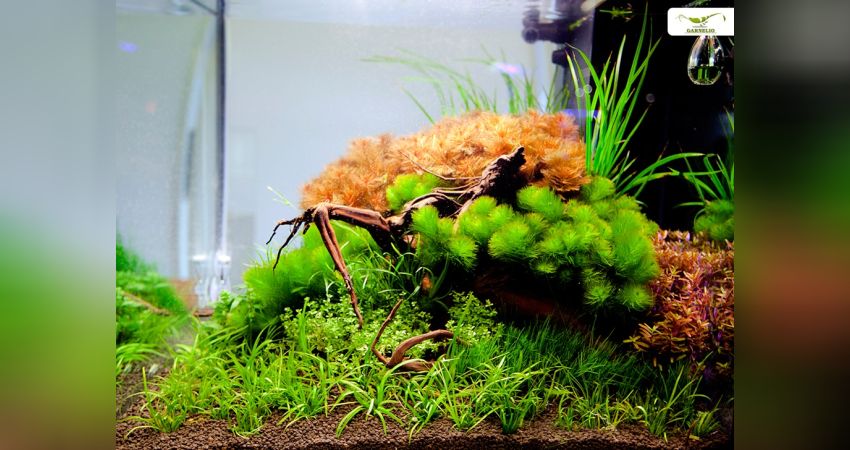A look beyond the rim of the teacup

This very readable guest article informs you about everything that has happened at the "sister of marine aquaristics" in the last few years. We found it very interesting, hopefully you will too ?
You could call it the older sister of saltwater aquaristics … and that's how saltwater aquaristics still sometimes comes across today: a bit staid, a bit big, with its always the same community tanks with the always the same meagre plants, big photos and the always the same fish - Neons, Guppies and Antennae Catfish, plus possibly Platies and Mollies. In the larger tanks, one occasionally catches the odd angelfish in the colourful fish soup … but you can do so many beautiful, interesting and above all visually appealing things in freshwater!
It all started when more and more colourful freshwater dwarf shrimps were imported. They can also be kept in small aquariums from 12 l. Over time, shrimp species crystallised that can be kept and reproduced well in freshwater, and new colour and pattern variations appeared — an almost inexhaustible cornucopia of nature (and the creativity of the breeders). The most popular shrimps at the moment are called Shadow Shrimps — these soft water shrimps originate from Taiwan. Through clever crossbreeding with other species and careful breeding, new colour forms and interesting pattern variations have emerged that are causing a sensation: Pintos, skunks and the like …
The Neocaridina shrimps, which are much easier to keep, have also produced many new colours and patterns in recent years - from red üorange to yellow, ülight blue, dark blue to black, green, white; and brown to striped forms, everything is here.



In the course of shrimp keeping, a lot has also happened with fish — the traditional fish from the old-fashioned community tanks have, in their majority, turned out not to be particularly compatible with shrimp. Therefore, mini fish have experienced a true renaissance, because they can be kept together very well with the quite small dwarf shrimps. Among them are not only corydoras, danios and rasboras, but also small viviparous species such as the Ender guppy or dwarf shrimp.
The fact that with shrimps small invertebrates suddenly became the focus of attention threw a new light on the previously hated snails. They gained new fans, and even among the small slimy ones there are colour breedings and interesting wild forms with great patterns that are kept consciously for their beauty.
The situation was quite similar for crabs and shrimps, which used to be kept only by a few specialists. In the wake of the shrimp boom, they have also entered the mainstream of the hobby. So it's fair to say that the little shrimps have given birth to a whole new way of keeping aquariums.
Further link: Dwarf Shrimp - https://www.garnelio.de/wirbellose/garnelen/
There is also a trend reversal in planted aquariums. Where there used to be meagre stems, today there are magnificent green and red plants. This type of plant aquaristics really began with Takashi Amano, a Japanese photographer and naturalist, who founded a new direction in aquaristics — aquascaping. Here, stones and wood are used to create a framework, which is then completed with plants. You can either recreate underwater habitats or transfer landscapes that you would actually find above water into the wet element. In the aquarium, this creates mountain landscapes or scenes with small hollow paths, but also jungle scenes or sections of a vast grassy landscape.

New plant species were and are needed here. Many of these were not sustainable with traditional methods and techniques, so new developments were needed such as CO2 plants, düng systems and new lights to provide the plants with essential nutrients and the right light. New planting and care tools were developed. While aquatics used to be more of a hobby for the little guy, today it has become a high-end area with aquascaping. As a result, plants can now be kept in the aquarium that were previously only known — short-growing ground covers, long-growing stem and grass plants, perennials, moss and ferns, red, brown and orange plants … they are all still special, but no longer a sensational exception.
As a countermovement to aquascaping with its sometimes very artistic sceneries, biotope aquaristics has also developed further. Here, great importance is attached to natural-looking aquariums that represent a section of the animals' habitat. Between dense branches in the water and large driftwood logs, the angelfish, which used to be so boring, suddenly look mysterious and exciting. Perches also gain charm in a natural environment. Even neons, which some people have seen enough of in the course of time, gain incredible colour brilliance in an animal-friendly blackwater aquarium and look simply fascinating.
Further link: Plant Aquarium - https://www.garnelio.de/aquariumpflanzen/
So there is a lot going on with the older sister, and a look at the bigger picture opens up completely new perspectives!
Many greetings
Farshad Farhadi (Author)
How do you like this article?
Info
Author

Bookmark
Comments
Topics
Similar articles
- Das große WM Gewinspiel - Wer wird Fussball Weltmeister 2010?
- A look beyond the rim of the teacup
- Die Knötchenkrankheit – Lymphocystis
- Gegen Algen und Cyanobakterien mit natürlichen Mitteln
- Eingewöhnung und Pflege von Centropyge venustus
- Importreise mit Ocean Marine Life Imports und Gerrit Meinen
- Tetrodotoxin - Das Gift des Kugelfisches
- Sommerfest bei Korallen Outlet der Bericht
- Unser neues Meerwasseraquarium – Ein Traum wird zum Alptraum!
- Ein Ratgeber für die riffaquaristische Praxis
Comments To the top
Please register
In order to be able to write something yourself, you must register in advance.






